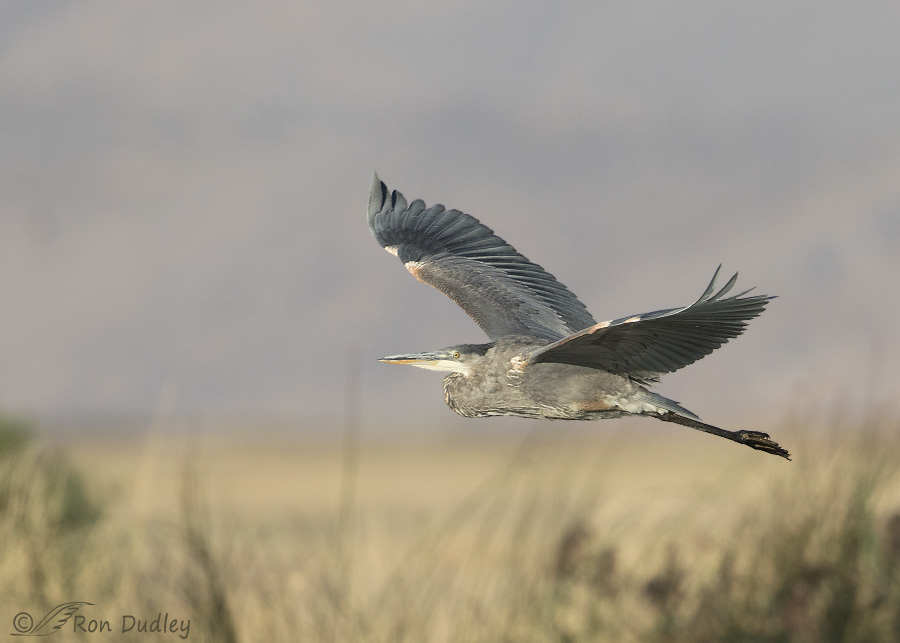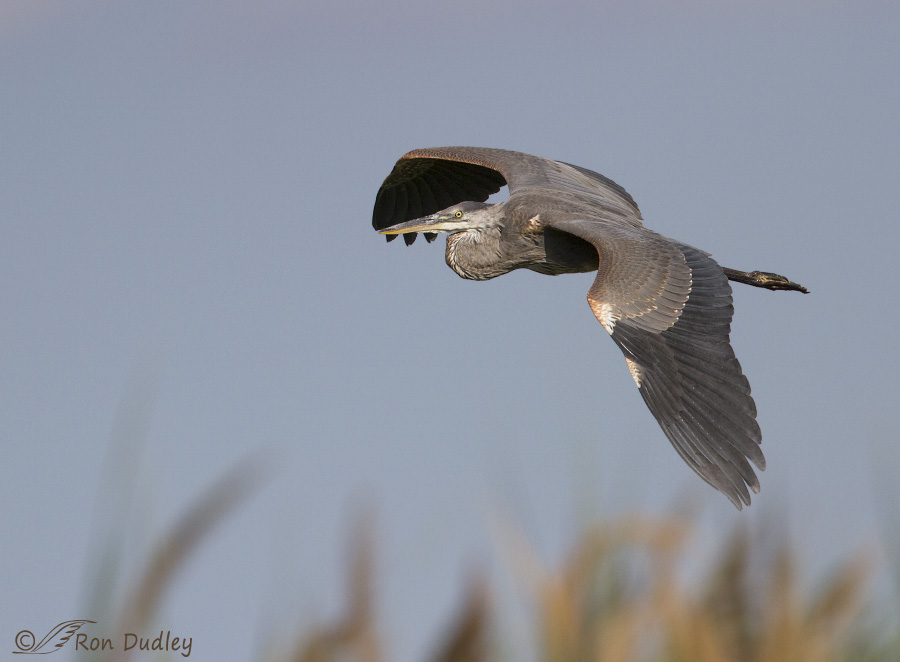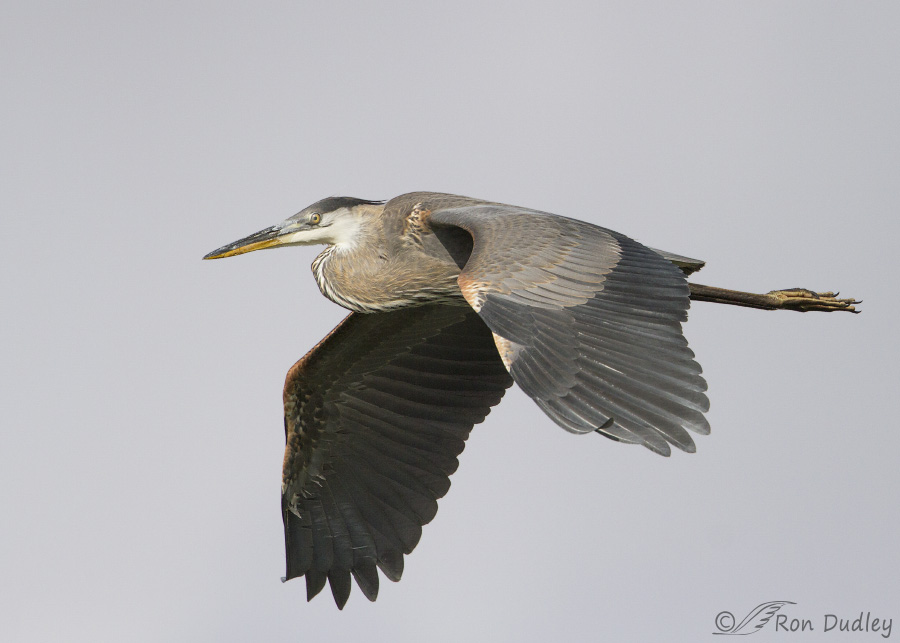Last month while photographing birds on the water at Bear River MBR I’d get the occasional and unexpected Great Blue Heron fly-by. I was able to get some shots I like reasonably well so I figured it was time to post some of them.
These images in progression include decreasing amounts of habitat in the frame.

1/2500, f/6.3, ISO 500, Canon 7D Mark II, Canon EF 500mm f/4L IS II USM + 1.4 tc, not baited, set up or called in
These were nearly always grab shots so I didn’t have (or take) the time to adjust camera settings for the varying brightness of the backgrounds. As a result (as you’ll see below) my shutter speed varied wildly since I shoot in aperture priority. Here the setting is the marsh at bottom and mountains up top so my shutter speed was appropriate for the situation.
 1/5000, f/6.3, ISO 500, Canon 7D Mark II, Canon EF 500mm f/4L IS II USM + 1.4 tc, not baited, set up or called in
1/5000, f/6.3, ISO 500, Canon 7D Mark II, Canon EF 500mm f/4L IS II USM + 1.4 tc, not baited, set up or called in
But when the setting and background was mostly brighter blue sky my shutter speed shot up accordingly. When cropping this image I placed the heron higher in the frame than I would normally in order to include more of the vegetation at bottom.

1/6400, f/6.3, ISO 500, Canon 7D Mark II, Canon EF 500mm f/4L IS II USM + 1.4 tc, canvas added for composition, not baited, set up or called in
When the background was even brighter my SS shot up into the “hummingbird in flight” range. I’d prefer more appropriate settings but I have enough depth of field to get both wingtips sharp and noise isn’t a significant problem so I see it mostly as a non-issue. Besides, at these long focal lengths (effectively 1120mm) high shutter speeds are always welcome for sharpness, especially when hand-holding that huge lens.
My preferred subjects for these sessions at Bear River were nearly always birds on the water and since their behaviors are unpredictable and fast it was my preference to have my settings appropriate for photographing them.
These herons in flight are simply a bonus.
Ron


I’ve been out of town quite a bit lately so you’ve probably already answered this but I missed it. What was the final fix on your focus problem with the previous 7D mark II and did you decide to keep it?
Larry, there has been no final fix. There’s been so much on my plate I haven’t sent it into Canon yet (otherwise called procrastination…)
Ron, I see that you use a Canon 7D Mark II, with a Canon EF 500mm lens. Does the lens have a range (e.g., 80-250)? Also, what kind of teleconverter do you have? I strongly suspect that your equipment is way out of my price range, but I would still like to know what you use. If you have posted about your choices in equipment, I would greatly appreciate knowing how to find that blog article. I am thinking about possibly getting a different camera, and I would value knowing how/why you chose yours.
Muffy, no, that lens is not a zoom. It’s what’s called a “prime lens” which means it has a fixed focal length.
My tc is the newer version 3 Canon 1.4.
Getting excellent image quality is largely a function of the quality and reach of your lens, not your camera. You’re much better off investing in quality lenses than you are in the “latest and greatest” cameras. Quality lenses last “forever” (and maintain their value) but cameras become obsolete relatively quickly. My lens is very expensive but last I heard you can buy a used one of the older version of that lens for less than half the price and that older lens is simply excellent.
Love, love,love the herons.
🙂
Ron,
A technical question. Was your aperture set at 6.3 specifically because you needed the DOF for wingspan focus , and is that your practice for big birds in flight. Thanks, John
John, you have to start somewhere so 6.3 is often my “default” aperture setting and then I adjust it as needed for DOF and shutter speed depending on the situation.
But here, as I said/implied in my post, I adjusted nothing (but EV) for these shots. They were grab shots as I was shooting shorebirds on the water.
To be perfectly honest I was just a little surprised that the tips of both wings are sharp at 6.3 in that last shot because I was fairly close to this large bird.
Again, oh WOW (insert string of superlatives here)! I just love watching herons. They’re just so COOL, despite that it’s a bit of a challenge for them to get into the air. While they certainly are prehistoric looking, existing on the planet before we humans slithered out of the mire, I think raptors own the pterodactyl designation 🙂 But I’m always knocked out by the direct connection of all birds back to the dinosaurs.
Thanks very much, Laura.
Echoing Laura, both on the wow front and on the dinosaur linkage. So many of your commentators have the unhygenic habit of taking the words from my mouth.
Ha, that’s so they’re already warm and prelibricated for them, EC! 🙂
They’re marvelous shots Ron! TThanks for sharing.
Charlotte
Thank you, Charlotte.
Very Beautiful. Even though you say they are slow I still am slower. I mostly have butt shots of herons.
I get a lot of butt shots too, April. It’s just that they don’t see the light of day…
Ron, love those pictures. We have those beautiful birds around Sheridan in the summer time.
Thank you, Trudy.
These shots are great. When I first moved to Virginia, I had a swamp behind my development, and used to go down there to see what was around. I will never forget the day I took a neighbor there and we accidentally flushed a couple of Great Blues. Their takeoff was so lumbering that I was surprised that they got into the air. They are very graceful fliers once in the air, but I think it’s miraculous that their takeoff works at all.
Susan, those relatively slow takeoffs and wingbeats (combined with their large size) are what makes the GBH a favorite subject for novice bird photographers trying to develop flight shot skills. My first attempts at flight shots were with Great Blues.
One of my first close encounters of the heron kind was on a foggy lake in Louisiana. I was at a Girl Scout camp. I’d gone out for an early morning canoe. Out of seemingly nowhere, a GBH called then flew right across the bow of my boat. The claws nearly grazed the craft. I remember holding my breath. I think the beauty of seeing that great bird so close mesmerized me. At that camp, there was a tale of two young Native Americans from differing tribes. One died and the other was turned into a GBH. We were told that GBH’s mate for life. Pretty typical camp mythology but it made a huge impression on me. 😀 The second picture is my favorite of the three.
That’s a neat story, Arwen. They don’t mate for life – most birds choose new mates each year but they are seasonally monogamous.
I’ll bet that first encounter is a memory that will be with you forever.
Looking at these images reminds how prehistoric they sound and how the hair on the back of my neck raised the first time I heard them! Also the slow, powerful, unmistakable wing strokes as they fly overhead, long legs trailing…I especially like the second and third….
Patty, they not only sound prehistoric, I think they look prehistoric – particularly in flight. They sometimes remind me a little of pterodactyls in flight.
That just what I was going to say but couldn’t remember how to spell pyerodactyl…
Don’t worry about your spelling, Patty. You can always blame it on your iPad… 🙂
Easy for you to say!
Evil iPad strikes again! I wrote “pterodactyl” and it changed it….
I’m always shooting in manual. When I try shooting in aperture priority the pictures are underexposed.?????? And opening aperture only increases shutter speed. ?? Your pictures are exposed perfectly. !!
Oh forgot I m having a hawk invasion. Neighbor to South of me cut hay . Neighbor to North cut hay. Mice are easy pickings. Vultures everywhere . 12 vultures cleaned up a dead sheep to a nice looking skeleton. I geuss I’m lucky in a way. Hawks vultures eagles kestrals flickers right in my back yard.not to mention all the tweetie birds bluegrossbeak swallows orioles ect. . now I’m going up grand mesa for 2 weeks. Hope to get some good pictures of stellar Jay.
Marina, I’m of the opinion that it doesn’t matter a lot whether bird photographers shoot in aperture priority or manual. What really matters is that whatever setting you prefer you practice enough with it so you become experienced and very good at it – to the point it becomes second nature.
When you’re shooting in aperture priority you often need to adjust EV (exposure value) for the situation to get proper exposure. But it’s very easy and quick to do so.
I’m envious of all the birds you have right now. It’s slow as molasses around here right now.
Beautiful flight shots of the Great Blue – maybe someday I’ll get a shot!
With a tall mug of coffee I sit here and marvel at your expertise. I am very envious of the spots you go to and the pict opportunities you have.
Wish you weren’t so far away!
Have a great weekend.
BTW – what kind of backup do you use?
Dick, don’t be too envious. Right now birds are so darned slow around here that I haven’t even gone out for a few days. I’m just hoping a few more migrants begin to show up soon.
If by “backup” you mean backup gear I always have one of my 7D’s mounted to my 100-400 on the seat next to me.
Sorry, I meant computer backup. I have been told with all the pictures I take and going raw I should go with two to three backups. I only have one at this point that is 1/2 full.
Also, if you want to go off list, it would be absolutely fantastic if you could tell me how you get rid of the vinyetting (sp) I get with my 100-400. raharlow@comcast.net
Thanks in advance.
Email sent, Dick.
Love the Great Blue’s! The second shot particularly appeals to me with sharpness, the light on the leading edge of the wings,and the contrast against the blue sky. Always amazing how much difference the background makes! 🙂 For big birds they are sometimes hard to catch!
“Always amazing how much difference the background makes”
Isn’t it, Judy! Thank you.